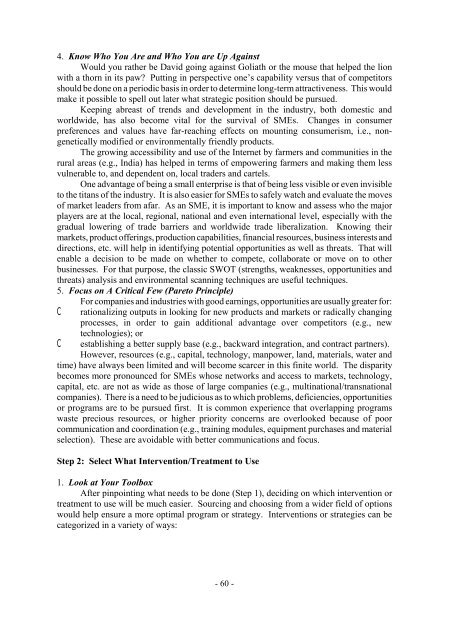Development of Agribusiness Enterprises - Asian Productivity ...
Development of Agribusiness Enterprises - Asian Productivity ...
Development of Agribusiness Enterprises - Asian Productivity ...
You also want an ePaper? Increase the reach of your titles
YUMPU automatically turns print PDFs into web optimized ePapers that Google loves.
4. Know Who You Are and Who You are Up Against<br />
Would you rather be David going against Goliath or the mouse that helped the lion<br />
with a thorn in its paw? Putting in perspective one’s capability versus that <strong>of</strong> competitors<br />
should be done on a periodic basis in order to determine long-term attractiveness. This would<br />
make it possible to spell out later what strategic position should be pursued.<br />
Keeping abreast <strong>of</strong> trends and development in the industry, both domestic and<br />
worldwide, has also become vital for the survival <strong>of</strong> SMEs. Changes in consumer<br />
preferences and values have far-reaching effects on mounting consumerism, i.e., nongenetically<br />
modified or environmentally friendly products.<br />
The growing accessibility and use <strong>of</strong> the Internet by farmers and communities in the<br />
rural areas (e.g., India) has helped in terms <strong>of</strong> empowering farmers and making them less<br />
vulnerable to, and dependent on, local traders and cartels.<br />
One advantage <strong>of</strong> being a small enterprise is that <strong>of</strong> being less visible or even invisible<br />
to the titans <strong>of</strong> the industry. It is also easier for SMEs to safely watch and evaluate the moves<br />
<strong>of</strong> market leaders from afar. As an SME, it is important to know and assess who the major<br />
players are at the local, regional, national and even international level, especially with the<br />
gradual lowering <strong>of</strong> trade barriers and worldwide trade liberalization. Knowing their<br />
markets, product <strong>of</strong>ferings, production capabilities, financial resources, business interests and<br />
directions, etc. will help in identifying potential opportunities as well as threats. That will<br />
enable a decision to be made on whether to compete, collaborate or move on to other<br />
businesses. For that purpose, the classic SWOT (strengths, weaknesses, opportunities and<br />
threats) analysis and environmental scanning techniques are useful techniques.<br />
5. Focus on A Critical Few (Pareto Principle)<br />
For companies and industries with good earnings, opportunities are usually greater for:<br />
C rationalizing outputs in looking for new products and markets or radically changing<br />
processes, in order to gain additional advantage over competitors (e.g., new<br />
technologies); or<br />
C establishing a better supply base (e.g., backward integration, and contract partners).<br />
However, resources (e.g., capital, technology, manpower, land, materials, water and<br />
time) have always been limited and will become scarcer in this finite world. The disparity<br />
becomes more pronounced for SMEs whose networks and access to markets, technology,<br />
capital, etc. are not as wide as those <strong>of</strong> large companies (e.g., multinational/transnational<br />
companies). There is a need to be judicious as to which problems, deficiencies, opportunities<br />
or programs are to be pursued first. It is common experience that overlapping programs<br />
waste precious resources, or higher priority concerns are overlooked because <strong>of</strong> poor<br />
communication and coordination (e.g., training modules, equipment purchases and material<br />
selection). These are avoidable with better communications and focus.<br />
Step 2: Select What Intervention/Treatment to Use<br />
1. Look at Your Toolbox<br />
After pinpointing what needs to be done (Step 1), deciding on which intervention or<br />
treatment to use will be much easier. Sourcing and choosing from a wider field <strong>of</strong> options<br />
would help ensure a more optimal program or strategy. Interventions or strategies can be<br />
categorized in a variety <strong>of</strong> ways:<br />
- 60 -
















